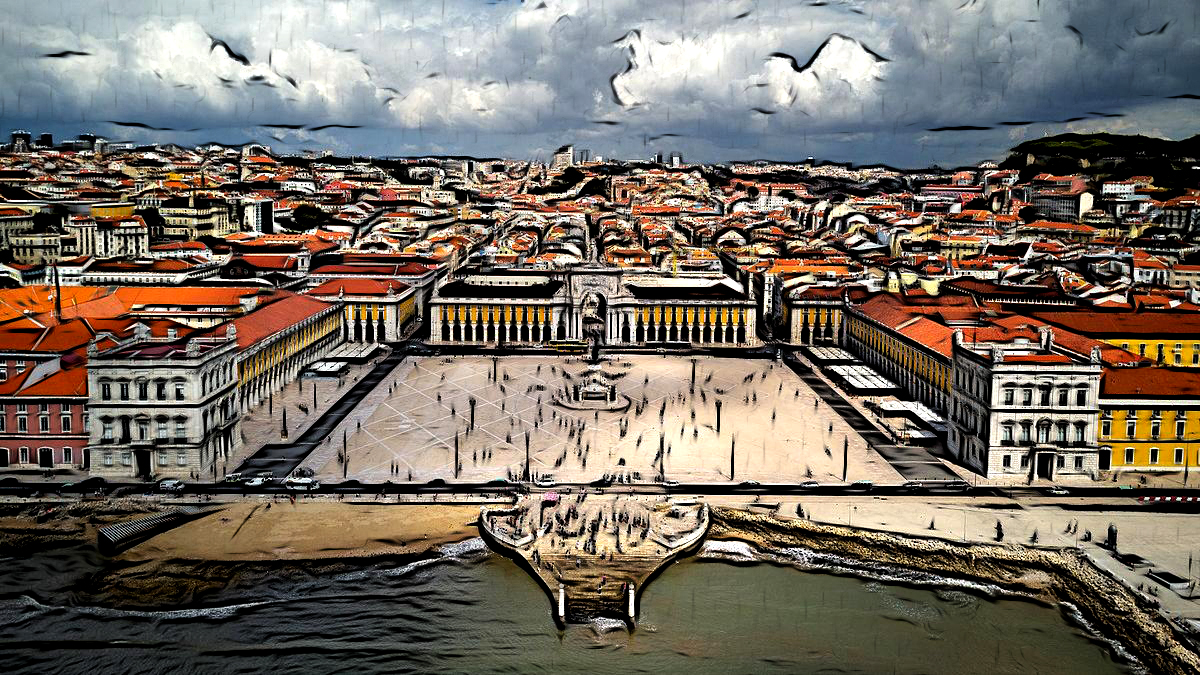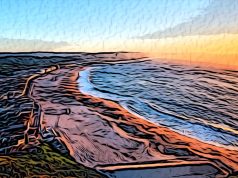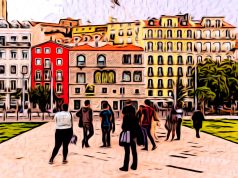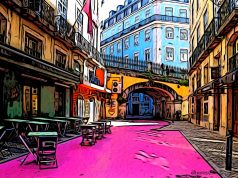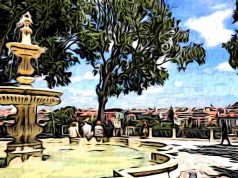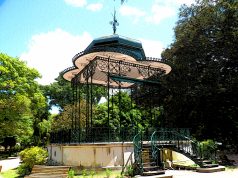Districts Of Portugal are full of surprises and gorgeous architecture, and Baixa is no exception. It’s a central and popular district in Lisbon with its streets, palaces, and places to hang out. You can enjoy your time in restaurants and bars, or go shopping and stay at great hotels including Hotel de Baixa. You’re sure to enjoy the neoclassical style of Pombaline architecture of the buildings as well.
The district was rebuilt after the earthquake of 1755, and the buildings were constructed as earthquake-resistant. The architecture of the buildings also boasts the pioneer of neoclassical design in Europe.
Let’s get to know more about this Lisbon Portugal downtown including where to go in Baixa.
How To Go: Baixa Lisbon Map
Baixa is a very central area that is connected to public transportation like buses, metro, and trains. You can also find connections from the airport to this district as well.
Baixo is also close to neighborhoods like Bairro Alto, Chiado, and Alfama. So, you can reach such areas by walking from Baixa.
If you have a Lisboa Card, you can use public transportation in the city for free. Such public transportation includes funiculars, trams, metro, and buses. If you use the metro, you can hop off at the Rossio station to visit Baixa.
Night Life in Baixa
The street Rua das Portas de Santo Antão is a very popular dining area with many great, touristy restaurants that stay open late into the night. However, the nightlife of Baixa is primarily focused on late meals, casual drinking, or performances in the theatres. Baixa is a good location for family evening meals and does not have a rowdy or chaotic atmosphere, as with some other districts. A trendy hang-out is the Rooftop Bar at the Hotel Mundial.
What is Baixa, and What To See in This District
The Baixi meaning the lower city is named after the Portuguese word Baixo which means low.
You can enjoy your time in Baixa by visiting on foot. The Rossio Square, Praça do Comércio, and Santa Justa Elevator are the popular areas to visit.
Let’s start with Praça do Comércio.
Praça do Comércio
The Commerce Square, Praça do Comércio, is a large square located in the Baixa district of Lisbon. There’s a statue of King José I at the center of the square. It was made in 1775 by the artist Joaquim Machado de Castro.
There’s a cafe called Cafè Martinho da Arcada which was very popular in the past. Especially intellectuals and artists used to visit this place. It’s still in operation, so you can sit and drink something here. Other places to visit in the square are Lisbon Story Center and ViniPortugal to taste wines. There’s also the Beer Museum where you can enjoy your beer.
Address: Praça do Comércio MB, 1100-148 Lisboa
Rossio Square
Officially known as Praca Dom Pedro IV, Rossio Square is another popular place that locals and tourists like to go to. This square in Baixa Portugal is characterized by the stones of its floor. It’s made up of black and white stones with a waving shape.
The square dates back to the thirteenth century and has a monument at the center as a commemoration of King Pedro IV.
There are some activities to do in this square of Baixa Lisbon. You can go to the Dona Maria II National Theater, or visit the Rossio Train Station. The Cafe Nicola is also available for you to enjoy your coffee and take a rest.
Address: 1100-240 Lisbon
Santa Justa Elevator
This downtown Lisbon elevator was inaugurated in 1902, and it is 45 meters high. It’s a popular landmark of Lisbon, built by a student of Gustave Eiffel, Raoul Mesnier du Ponsard. On top of the elevator, you’re provided with a 360-degree view of the city. Connecting Baixa to Carmo hill, it often has a long line of visitors.
Address: R. do Ouro, 1150-060 Lisboa
Casa do Alentejo Restaurant and Palace
Casa do Alentejo is a glorious place that was once a Moorish palace. It has an astonishing courtyard, and it’s very close to Rossio Square in Lisbon Downtown. The building dates back to the 17th century, and it stood the great earthquake of 1755. It then underwent some changes in 1918.
Upstairs, you can find the restaurant and the ballroom. There are two dining rooms at the restaurant. They’re gorgeous with their walls decorated with Portuguese tiles. You can enjoy several Portuguese meals and desserts at the restaurant.
Address: R. das Portas de Santo Antão 58, 1150-268 Lisboa
Rua Augusta: The Street and Rua Augusta Arch
Rua Augusta Street and the arch at the street are other popular places to visit in Lisbon Baixa. You can spend time in the cafes and shops on this busy street. There are also street performers here.
The famous arch at Rua Augusta is an iconic monument designed in the 18th century. In 1875, it was redesigned. Finally, an elevator was added in 2013. Thanks to the terrace on the top, visitors can now enjoy the views of downtown Lisbon Portugal.
Address: R. Augusta 2, 1100-053 Lisboa
Praça da Figueira
Praça da Figueira is another popular square in Baixa Chiado, and it’s connected to Rua Augusta. It’s also very close to Praça do Comércio. Once a month, a food market called Mercado da Baixa takes place in this square. There’s also a statue of King Joao I here. Tram 15 and Bus 737 pass through this street as well.
Address: Praça da Figueira 1100-241 Lisboa
MuDe – Design and Fashion Museum
If you have time, you can visit MuDe in this Lisbon district. The museum opened in 1999, and it’s now one of the best design museums in Europe. There’s also a fashion collection inside.
There are various pieces and creations of famous international designers. Some of them belong to Yves Saint Laurent, Christian Dior, and Charles and Ray Eames.
Address: R. Augusta 24, 1100-053 Lisboa
So, Baixa offers many activities to enjoy when you visit Lisbon. Pay a visit to these historical areas on your next visit!
FAQ
What is Baixa?
Baixa is a historic neighborhood in Lisbon, Portugal. It’s known for its traditional 18th-century architecture and its lively streets filled with shops, cafes, and restaurants. The area is also home to the iconic Praça do Comércio square, plus a number of other landmarks and attractions. Baixa is the perfect place to explore if you’re looking for a vibrant atmosphere and a taste of Portugal’s past.
What is the history of Baixa?
The area now known as Baixa was once home to a small fishing village, before the devastating 1755 earthquake that struck Lisbon. After the earthquake, Portuguese monarch Joseph I decided to rebuild the city’s downtown area in a neoclassical style, creating what we now know as Baixa. Today, the area is a bustling hub of activity, full of historic sites and modern amenities. It’s no surprise that Baixa has become one of Lisbon’s most popular tourist destinations.
What can you do in Baixa?
Baixa offers plenty to do, whether you’re looking to explore the city’s past or enjoy its modern attractions. From admiring centuries-old architecture to shopping in the downtown stores, you’ll find something to do here. Plus, there are plenty of restaurants and cafes for when you need a break from sightseeing. Make sure to check out the iconic Praça do Comércio square, with its view of the Tagus River, before you go. Whether you’re looking for culture or relaxation, Baixa has something for everyone.
How do I get to Baixa?
Baixa is easily accessible from all parts of the city. You can take the metro to one of the many stations in and around Baixa, or take a bus or tram. There are also several car parks in the area if you’re driving. Whatever your preferred mode of transport, you’ll find it easy to get to Baixa.
What are some things to do in Baixa?
Whether you’re in the mood for sightseeing or shopping, Baixa has something for everyone. Start by exploring the cobblestoned streets and admiring the traditional 18th-century architecture. Then, wander around the many shops and cafes that line the streets. Don’t forget to check out the iconic Praça do Comércio square and the many other landmarks that make Baixa such a popular destination.
What are some good restaurants in Baixa?
When you’re ready for a bite to eat, there are plenty of restaurants in Baixa to choose from. Try one of the local seafood favorites such as bolinhos de bacalhau or grilled sardines. Or, why not sample some of Portugal’s delicious pastéis de nata, the famous custard tarts? There are also plenty of international options if you’re looking for something different.
What are some good hotels in Baixa?
Baixa is home to a number of excellent hotels, ranging from budget to luxury. Whether you’re looking for a modern stay or something more traditional, you’re sure to find what you’re looking for in Baixa. Popular choices include the Altis Prime Hotel and the Mercure Lisboa Liberdade.
What are some safety tips for Baixa?
Baixa is generally a safe area to explore, however, as with any city, it’s important to practice basic safety precautions. Be aware of your belongings at all times and keep valuables out of sight. Be aware of your surroundings, avoid dark alleys and deserted streets, and trust your instincts. It’s also a good idea to travel with a friend, especially at night.
What are some good shopping options in Baixa?
If you’re looking for some retail therapy, Baixa is the perfect place to shop. There are plenty of stores selling traditional Portuguese souvenirs, as well as modern shops with designer brands. You can also find plenty of traditional food markets throughout the area, where you can pick up fresh produce and delicacies. Plus, there are several malls for when you need a break from the cobblestoned streets.
What is the best time to visit Baixa?
Baixa is a great destination all year round, but the best time to visit is during the summer months. From late May to September, the sun is shining and the days are long. Plus, there are plenty of outdoor activities on offer such as beach volleyball, sailing, and hiking. If you’re looking for a lively atmosphere, the summer months are definitely the best time to explore Baixa.
What is the nightlife like in Baixa?
If you’re looking for a night out on the town, Baixa has plenty to offer. There are several trendy bars and clubs located in and around the area, as well as a few traditional Portuguese restaurants where you can sample the local cuisine. There’s also live music playing in several venues throughout the week, so you’re sure to find something to suit your tastes.

